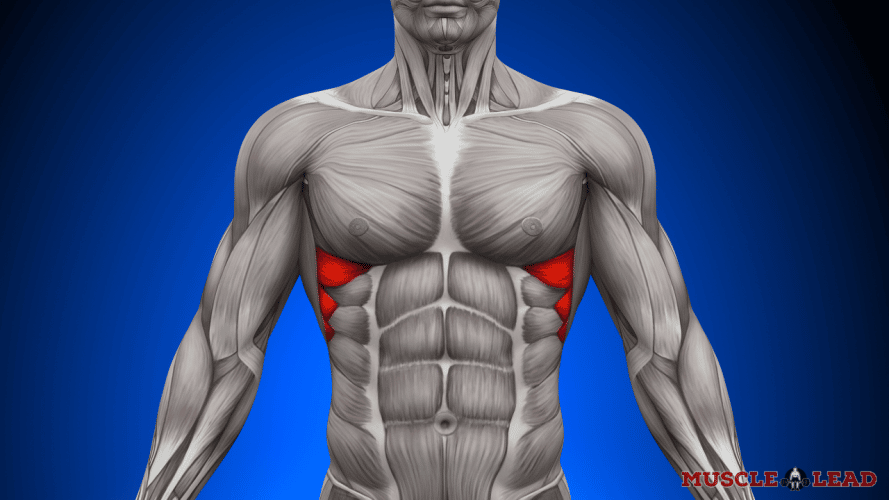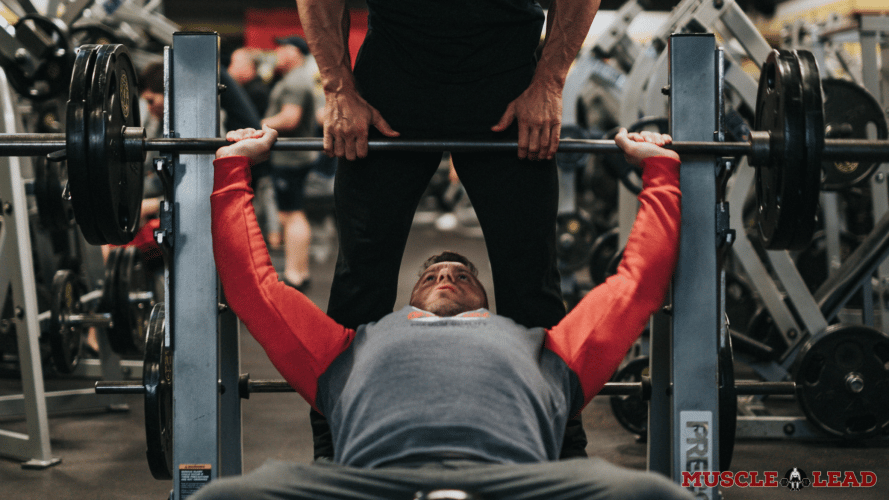Key Points
- Stability, reduced back pain, increased strength and shortened range of motion are some the benefits of using a lifting belt for bench press.
- You can either buy a dedicated lifting belt for bench press or use your regular belt you’re using for all lifts.
- Benching with a belt can reduce the risk of shoulder injury.
- Be sure you know how to use a lifting belt as it can cause discomfort or even become a crutch in your training.
Weightlifting belts and powerlifting belts are becoming more commonplace in gyms everywhere.
If you take a look in any lifters bag, 9 times out of 10 they got a belt in there.
Commonly, lifting belts are used for exercises such as the squat and deadlift. However, even some of the top powerlifters in the world use a weightlifting belt for bench press.
This article will discuss the benefits and drawbacks of wearing a lifting belt for bench pressing. You can then use the information to assess if you as an individual would benefit.
10 Benefits of Wearing a Lifting Belt When Benching
1. It Keeps You More Stable
A good stable base is the foundation of a strong and safe bench press.
Narrow commercial gym benches can often make achieving this base more challenging. Many people develop shoulder impingement or other minor problems while bench pressing.

A study by Kaur et al. (1) found a link between wearing a belt while bench pressing and stability of the serratus anterior (SA). A more stable SA, means a more stable bench press position.
This decreases the risk of injury and promotes an even pressing force.
2. The Placebo Effect
A lot of the time, more confidece can make the difference between a good workout and a bad workout. The feeling of doubt can amplify the difference in performance when bench pressing heavy loads.
Now don’t get me wrong, some lifters may feel no difference in physical performance. However, confidence under a heavy load can be the difference between completing a set or not.
3. Reduced Back Pain
Benching with a belt forces your back/spine into a more neutral position. When the back is loaded it is crucial that the spine remains neutral.
A safer back position can lead to reduced pain caused by the fatigue from other powerlifting exercises. Reduced pain and risk of injury leads to greater longevity and potential for improvement in the bench press movement.
4. Helps Promote a More Stable Arch
As previously mentioned the lifting belt can aid with the stabilization of the shoulders.

In addition to shoulders, the belt can help stabilize your arch during the bench press movement. Don’t forget that the bench press is a total body movement. Your back gets involved. Your feet get involved and your abs get involved.
With the belt on, your arch is able to stay within a safe range and help with core strength.
Overall, you should see an efficient movement while bench pressing with the arch.
5. Specificity
In most powerlifting federations, it states that lifting belts may be worn in competition. If you plan on competing with a belt, I would recommend wearing one for your training in the gym.

This allows you to train as close to the competition environment as you possibly can.
This means come competition day, you won’t have to alter your form, worry about breathing, belt tightness, or set up. This way of thinking is very common for top level powerlifters. A few weeks prior to competition many top-level powerlifters will wear their singlets to simulate the feeling of competition day.
6. Shortened Range of Motion (Possibly)
Now this benefit may only affect a small percentage of readers, although I believe it’s definitely worth mentioning. We all know the bigger the arch, the shorter the range of motion. In turn, this can have a huge impact on the amount of weight an individual can press.
Using a belt can push stomach fat upwards to where the bar sits while waiting for the press command. Obviously for most readers this difference sounds almost comical.
However, if you are a larger individual (which a lot of the top powerlifters are), it can make a big difference.
7. It Helps with Equipped Lifting
This benefit will only affect equipped lifters, but it is still worth noting. Wearing a weightlifting belt for bench press prevents the bench suit from riding up your body. Prevention of the suit riding up can stop the suit from choking you and disrupting the bar path.
8. It Enhances the Valsalva Maneuver
The Valsalva maneuver is a breathing technique that creates internal pressure. This technique can be utilized by taking a deep breath in and pushing out, without letting air withdraw.
In turn, this creates a lot of intra-abdominal pressure which keeps you stable during movements and reduces force transfer losses. Using a lifting belt increases the effect of the Valsalva maneuver, as your body has something to press against.
9. Increased Strength
You may be getting through this list with few of them applying to you or none. However, if I can emphasize one major benefit, it would be greater strength increase.
Now, this change may not happen immediately or as noticeable as wearing a belt for deadlifts or squats. But over time it should make an impact.

Unless you are a complete beginner or a freak of nature then even the little wins should be valued. Even if the belt gives you the confidence to push out 1 extra repetition. Or if the belt helps with preventing shoulder injury by a slight amount. Those little wins have the potential of being exponential.
Should You Use A Lifting Belt for Overhead Press?
10. The Belt Flick
The final benefit on this list could be by far the most important.
The ‘belt flick’ after finishing a heavy set or hitting a new PR is one of life’s greatest pleasures. Anyone who disagrees with this or doesn’t think I’m being serious has never owned a lever belt.
3 Drawbacks of Using a Lifting Belt for Bench Press
1. Masking Underlying Problems
If you’re in the market for a lifting belt because your lower back is hurting, first consider other options.
Lower back pain can be caused by several issues in form, intensity of training or lack of sleep and nutrition. Many people quickly resort to buying equipment as these other methods of improvement seem unattractive. Taking a step back may feel like the opposite of progress, but your long term health will benefit.
Ask strong powerlifters, and I am sure they would recommend all factors listed as a priority. Below are some tips for alleviating lower back pain and lessening the chance of it getting worse/ coming back.
2. Restricted Breathing
From anecdotes of other lifters, some do struggle to breath while wearing a belt. Although there are no studies showing it restricts airflow while bench pressing, my personal experience is different.
While wearing a belt during high rep sets I can feel more discomfort, possibly related to breathing difficulties.
3. Practicality
Using a lifting belt for bench press has to be practical for you.
Do you want to take a belt to the gym along with all your essentials in your gym bag? Once the novelty of a new piece of equipment wears off, many lifters find the heavier gym bag inconvenient.
This could make a difference on the days when you really don’t feel like going to the gym. This can result in greater inconsistencies in training and money wasted on a belt.
What to Look for in a Lifting Belt for Benching?
Now, I know what you’re probably thinking. I’m going to recommend those 2-inch bench specialized lifting belts. Well personally, I don’t think they are necessary and here is why. If you’re in the market for a lifting belt you are probably considering using it for squat and deadlift too.
If this is the case a regular 13 or 10mm (4-inch length) belt would be a better all-round purchase. The belt would more likely to add weight to your max squat and possibly deadlift.
The other scenario is you already have a dedicated belt for squats and deadlifts, so you’re thinking about buying a specialized one for bench press.
If money is no object, and you are perfectly comfortable taking two gym belts in your bag, then go right ahead.
If not, I believe the more practical solution is to just use your regular belt for all lifts. You do not need to worry about the size, as it should have little to no effect on the bench press whatsoever.
Best Way to Use a Lifting Belt for Bench Press
Position
The belt should be positioned at the waist, usually at the lowest point before interfering with your hip bones. This position does vary from person to person though. For instance, some deadlifters prefer to sit the belt much higher. Lifters also experience pinching when first wearing a belt, this is completely normal and the pain should ease with time.
Tightness
Belt tightness is a highly individual preference, and it can also vary on each lift.
Guide: How Tight Should a Lifting Belt Be
Tips to Protect Your Shoulder While Bench Pressing
As mentioned in benefit #2, wearing a belt can reduce the risk of shoulder injury. In addition, here are some alternatives to protect your shoulders as much as possible.
Warming up Opposing Muscles
Doing a few sets of light lat pulldowns or rows can get blood into the back and get the muscles fired up. This in turn creates a more stable and safer base for you to press from.
External Rotations
The shoulder joint allows for internal rotation and external rotation. Heavy pulling and pressing exercises strengthen the muscles of the rotator cuff for internal rotation, but neglect external rotation work.
For this reason, I would recommend exercises such as banded external rotations as a warm-up for heavy bench press.
Correct Setup
When setting yourself up on the bench press, it is crucial you keep your shoulders in a safe position. This position can be achieved by retracting and depressing your scapula. This along with an arch in the back should protect your shoulders.
Final Thoughts
To summarize, lifting belts have their upsides and downsides. It is up to the individual to decide whether a belt is necessary to use for bench press.
If you don’t already own a belt, try someone else’s first.
The safest option would be a 11mm prong belt as it’s the cheapest and most versatile option. If you buy a lifting belt and don’t feel the difference in your bench press, worry not. You now have a lifting belt that will help you get stronger for squats and deadlifts.
FAQs
Most powerlifters wear a lifting belt for benching. The belt can help stabilize your arch and increase core activation. In addition, the lifting belt can help boost your confidence during heavy lifts.
Warming up opposing muscles, external rotations and correct setup on the bench press are some alternatives to protect your shoulders while bench pressing.
References
- Kaur, N., Bhanot, K., Brody, L.T., et al. ‘Effects of lower extremity and trunk muscle recruitment on serratus anterior muscle activation in health adult male’ International Journal of Sports Pysical Therapy. 2014; 9(7): 924–937
- Milewski, M., Skaggs, D., Bishop, G., et al. ‘Chronic Lack of Sleep is Associated With Increased Sports Injuries in Adolescent Athletes‘ Journal of Pediatric Orthopaedics. 2014; 34(2):129–133





